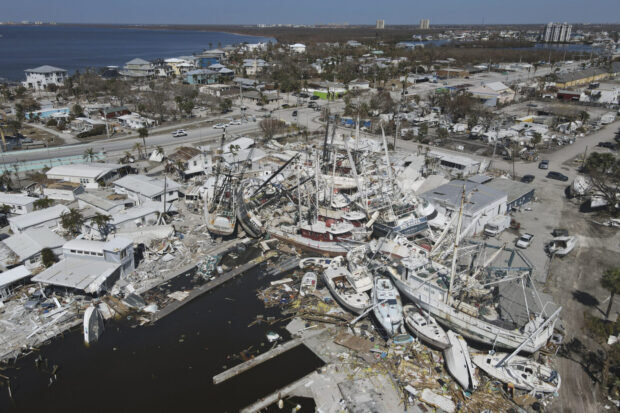We are in the early stages of sifting through the debris of Hurricane Ian and calculating the financial and human toll it took after coming ashore in Southwest Florida with 150 mph winds and 20 inches of rain. The insured losses expected to flow from this natural disaster are still being calculated, but estimates range from $60 billion to more than $80 billion, and some are already speculating as to where this storm ranks among the top 10 natural disasters in U.S. history.
Ranking natural disasters tends to be somewhat arbitrary. Whether or not a storm that kills three people is worse than one that causes $1 billion in damages is perhaps something that should be left to philosophers and theologians. Ranking the “deadliest” natural disasters would undoubtedly result in a slightly different list. However, in the context of subrogation and with relevance to the insurance industry, for purposes of the following list particular weight is placed on physical property damage, although both loss of property and loss of life affect the insurance industry.
In terms of U.S. natural disasters, perhaps it can be said that America has been lucky. None of the 10 worst natural disasters in U.S. history even make the top 10 deadliest natural disasters in world history. For example, Wuhan, China, makes news again when you consider that the deadliest natural disaster in the history of the planet was the 1931 China floods. These were a series of floods that occurred from June to August 1931 in China, hitting major cities such as Wuhan, Nanjing and beyond and resulting in the deaths of 4 million people.
However, using the conservative estimate of $25 billion in damages from Hurricane Ian, the list of the top 10 worst natural disasters in U.S. history (based solely on a financial toll and insurance losses caused in 2022 dollars) looks something like this:
Winter Storm Uri – Feb. 13-17, 2021. The North American winter storm, unofficially referred to as Winter Storm Uri, was a major winter and ice storm that struck during the week of Valentine’s Day and had widespread impacts across the U.S., Northern Mexico and parts of Canada. The storm hit states such as Texas particularly hard and caused an estimated $195.6 billion in property damage. It is now the most expensive natural disaster in the history of the U.S. The storm left millions without power for up to a week and millions of residences sustained broken pipes, flood damages and catastrophic losses to property. Following the storm, the attorneys at MWL began to investigate how and why the power grid in Texas failed. What we discovered was that the loss of power likely could have been prevented but for the negligence of the power providers and the Electric Reliability Council of Texas (ERCOT), who manages Texas’ power grid.
Hurricane Katrina — Aug. 29, 2005. The Atlantic storm, which began as a category 1 hurricane as it blew across southern Florida, wound up being the country’s costliest tragedy. Katrina roared into the Louisiana coast with 125 mph sustained winds, causing a storm surge that broke levees that shielded New Orleans from surrounding, higher coastal waters and leaving 80 percent of the city under water. Katrina killed at least 1,836 people and inflicted an estimated $150 billion in damages.
Hurricane Galveston — Sept. 8, 1900. Galveston was known at the end of the 19th Century as the “Jewel of Texas” until the single deadliest natural disaster in U.S. history wiped away much of what had been a booming future. The bustling island community had been the hub of the cotton trade and Texas’ largest city. Progress bred complacency though, which became apparent when city officials and residents decided against building a seawall to protect the city. When the category 4 hurricane with estimated 135 mph winds made landfall in the early morning, buildings crumbled under the force of 15-foot-high waves. By late afternoon, the entire island was submerged. An estimated 8,000-10,000 people perished. The city sustained $105 billion in damages. Although the city was successfully rebuilt, it never regained the prosperity that earned it a reputation as the “New York of the south.”
Dust Bowl – 1930s. Prior to the early 1930s, the Great Plains was a farmer’s paradise. Rising demands for wheat spurred settlers to plow much of the southern plains’ grassy soil to meet this need. The land was eventually exposed to erosion, since the grass and tree roots that had held the moist soil in place during dry times were replaced by cash crops. A decade-long drought transformed the loose topsoil into dust, which windstorms swept up and blew eastward, darkening skies as far away as the Atlantic Coast. With most of the area’s crops decimated, a third of the farmers turned to government aid, while around half-a-million Americans were left homeless. An estimated 3,000 people died and there was $100 billion in damages.
Hurricane Ida – Aug. 26, 2021. Scarcely a year ago, the deadly and destructive Category 4 Atlantic hurricane became the second-most damaging and intense hurricane to make landfall in Louisiana on record, behind Hurricane Katrina in 2005. It’s maximum sustained winds at landfall (150 mph) ties 2020’s Hurricane Laura and the 1856 Last Island hurricane as the strongest on record to hit the state. The remnants of the storm also caused a tornado outbreak and catastrophic flooding across the northeastern United States, resulting in total damages of at least $65 billion across the country.
Heat Wave of 1988. A year-long drought that had ravaged the agricultural economy was further exacerbated by the heat wave of 1988. Damage to the agricultural economy surpassed $61 billion, as total rainfall along the Great Plains region from April through June was even lower than during the Dust Bowl years. Drought conditions seeded wildfires that raged across Yellowstone National Park and Mount Rushmore that summer. Approximately 5,000 people died due to health complications stemming from the sweltering heat.
Hurricane Ian – Sept. 29, 2022. The hurricane made landfall in Florida as a powerful Category 4 storm. Maximum sustained winds were around 150 mph as it hit the southwest coast at the island of Cayo Costa near Fort Myers and Cape Coral. Within four days, more than 2.5 million residents were without power. Wind and storm surges resulted in the death of 86 persons and counting, and an estimated property damage of $60 billion.
Heat Wave of 1980. The heat wave of 1980 proved to be one of the nation’s most catastrophic prolonged weather events. A high-pressure ridge pushed temperatures across the central and southern U.S. above 90 degrees Fahrenheit for most of the summer. Agricultural damage tallied an estimated $48 billion due to a massive drought, and 1,700 people died from heat and heat stress-related ailments.
Great San Francisco Fire and Earthquake – April 18, 1906. It lasted no more than a minute but set off a chain of events that caused the city to burn for four straight days. The estimated 7.7- to 7.9-magnitude earthquake not only broke natural gas mains, which sparked the fires, but also damaged water mains, leaving the fire department with limited resources to battle the blaze. By the time the fires were doused, flames had devoured more than 500 city blocks, 3,000 lives were lost, and there was $30 billion in damages. Of those who survived, approximately 225,000 people found themselves without a home.
Lake Okeechobee Hurricane – Sept. 16, 1928. The hurricane crossed over the lake in central Florida west of Miami, killing at least 2,500 and causing $18 billion in damage. When the evacuated residents of Lake Okeechobee learned that a hurricane hadn’t arrived on schedule, many returned home, thinking they had been spared. The storm, however, slammed ashore later on the evening of September 16 with sustained 140 mph winds. Such intensity broke a small dike at the lake’s south end, resulting in weeks of heavy flooding.
In the casino-like world of underwriting, insurance companies wager against catastrophic natural disasters big enough to put them into receivership. Insurance is the thin white line that separates us from destitution and anarchy when God sends a hurricane, tornado, flood, wildfire, earthquake or other natural disaster. Aggressive subrogation practices ensure that insurance companies are not left standing alone when devastation takes place. Damage that could have been prevented but for the negligence of a person or company should be borne by the wrongdoer. That is the function and purpose of subrogation.
Photo: Shrimp boats lie grounded atop what was a mobile home park following the passage of Hurricane Ian. (AP Photo/Rebecca Blackwell)





















 How Carriers Are Pairing AI and Process Discipline to Drive Subrogation Outcomes
How Carriers Are Pairing AI and Process Discipline to Drive Subrogation Outcomes  Examining 5 Key Factors Fueling MGA Growth—and Emerging Challenges Ahead
Examining 5 Key Factors Fueling MGA Growth—and Emerging Challenges Ahead  Executives on the Move at HSB, American Modern Insurance Group, AIG
Executives on the Move at HSB, American Modern Insurance Group, AIG  The Hardest Part of Innovation in Insurance Isn’t Technology; It’s Culture
The Hardest Part of Innovation in Insurance Isn’t Technology; It’s Culture 



